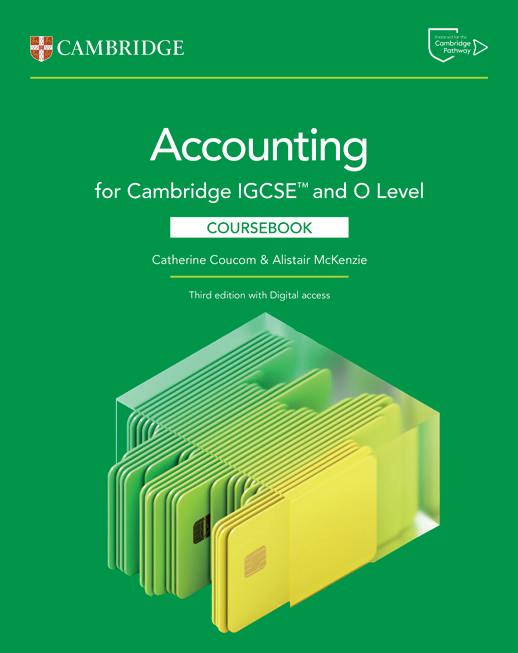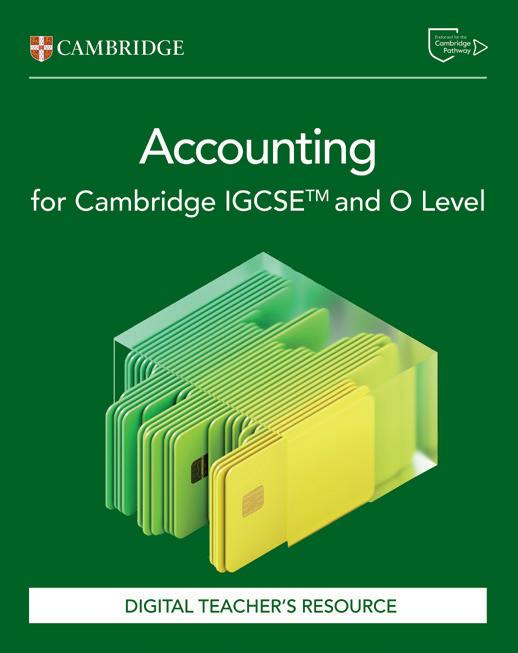We


We

We are working towards endorsement of this title for the Cambridge Pathway.
This new and updated edition of the coursebook will help you while studying the Cambridge IGCSE, IGCSE 9-1 or O Level Accounting syllabuses (0452/0985/7707) for examination from 2027.
You might be using this coursebook and studying accounting to enable you to take advantage of the wide range of opportunities which come from having a firm grounding in the purpose and role of accounting. You may wish to continue studying beyond Cambridge IGCSE/O level. You may even be thinking about a career in accounting or a related profession, or hope to set up your own business in the future.
This coursebook covers all the topics included on the latest syllabuses for Cambridge IGCSE and O Level Accounting, and is divided into four sections. Each section is subdivided into chapters based on topics from the syllabus. The topics are not necessarily included in the order in which they appear in the syllabus, but are arranged in a suitable order for an accounting student commencing a course at this level.
No prior knowledge is required, as this book provides an introduction to accounting and covers all the topics on the syllabus. Each chapter is complete in itself and contains detailed descriptions of the topic supported by worked examples, activities, practice questions, tips and key terms. There are also discussion questions and sections on accounting in context and accounting in action, which allow you to develop your understanding of the role of accounting in the world of business.
The coursebook is designed to help you build your confidence and understanding of accounting. As you progress through your course and this coursebook, you will start to see links between the topics and chapters. For example, at the start of Section 3 you are introduced to elementary financial statements in Chapters 8 and 9, and then later chapters in the same section explain how these statements are affected by various year-end adjustments.
We hope that you enjoy using this coursebook and wish you every success in your accounting course.
Catherine Coucom and Alistair McKenzie
How to use
All the components in the series are designed to work together.

The coursebook is designed for students to use in class with guidance from the teacher. It offers complete coverage of the Cambridge IGCSE™, IGCSE (9-1), and O Level Accounting syllabuses (0452/0985/7707). The coursebook is divided into four sections, and contains in-depth explanations of Accounting concepts, a variety of independent and group activities, as well as engaging new features and images to help students make real-world connections.
A digital version of the coursebook is included with the print version and is also available separately. It includes access to video content to further support students’ learning, as well as simple tools for them to use in class or for self-study.
The workbook provides further practice of all the skills presented in the coursebook and is ideal for use in class or as homework. It provides engaging exercises, worked examples, and opportunities for students to evaluate sample answers so they can put into practice what they have learnt.
A digital version of the workbook is included with the print version. It includes simple tools for students to use in class or for self-study, as well as downloadable templates to complete some of the activities.

All answers are available on Cambridge GO We

The digital teacher’s resource provides everything teachers need to deliver the course. It is packed full of useful teaching notes and lesson ideas, with suggestions for differentiation to support and challenge students, ideas for formative assessment, overcoming common misconceptions and language support.
The digital teacher’s resource contains downloadable resource sheets and worksheets.
Throughout this coursebook, you will notice some features that are designed to help your learning. Here is a brief overview of what you will find.
Learning intentions open each chapter. These help you navigate through the coursebook and indicate the important topics in each chapter.
Accounting in context introduces you to the content in a chapter. It places some of the key ideas contained in each chapter within more of a real-world setting, and includes questions that allow you to discuss the topic.
Key vocabulary is highlighted in the text when it is first introduced. An accompanying definition tells you the meaning of these words and phrases. You will also find definitions of these words and phrases in the Glossary at the back of this book.
Tips are provided throughout this coursebook to help with your learning. The tips might cover advice on answering questions, key skills for your course, or how to avoid common errors or misconceptions.
These explain the links between topics in different sections of the coursebook.
There are various activities throughout this coursebook. These give you the opportunity to discuss topics or produce your own work either individually, in pairs or in groups.
The Worked examples in the coursebook take you through the steps involved in completing an activity and will help you to understand what a successful answer looks like. These also provide support in developing the key skills that are needed for your course.
Accounting in action provides an insight into how the key concepts for this course might apply within a business or workplace setting. Designed to encourage group discussion, the short case studies and accompanying questions will help you to make connections between employment and studying accounting.
Discussion questions are used throughout this coursebook to prompt thinking at key points within each chapter.
Reflection activities enable you to look back on your work and encourage you to think about your learning. You will reflect on and assess the process that you used to arrive at your answers.
At the end of each chapter, you will find a list that brings together the key information you have learnt. This list can also be useful as a revision aid.
Each chapter contains a set of practice questions that are similar to questions you might find in your assessments. The questions focus on the syllabus assessment objectives –knowledge and understanding, analysis and evaluation. We are
Each chapter ends with a grid showing the Learning intentions from the start of the chapter. When you are revising, you might find it helpful to rate how confident you are for each of these statements. You should also provide an example to support your score.
These practice questions provide further examples of the sort of questions that you might find in your assessments. The questions focus on the assessment objectives that you will need for your course –knowledge and understanding, analysis and evaluation.
We are working towards endorsement of this title for the Cambridge Pathway.

By the end of this chapter, you will be able to:
• explain the double entry system of book-keeping and use it to process accounting data
• balance ledger accounts
• prepare and interpret ledger accounts and their balances
• record transactions using ledger accounts
A business would find it impossible to prepare a statement of financial position after every single transaction. The day-to-day transactions are recorded in the books of a business using the double entry system of book-keeping. The term ‘double entry’ is used because the two effects of a transaction (a giving and a receiving) are both recorded in the ledger.
A business maintains a separate ledger account for each type of asset, income, expense and liability, and also for each individual credit customer and credit supplier. Every transaction is recorded in the ledger account relating to that particular item or person.
A ledger is traditionally a bound book where each account appears on a separate page. Over the years, the ledger developed into a looseleaf folder with separate sheets, each containing a ledger account. Many businesses now use accounting software, so a separate ledger account for each item or person can be maintained and accessed on a computer.
Traditional or

When a new business is formed, it is important that the owner sets up a system for recording all the transactions made by the business. These records can be kept using a traditional manual system or by using an accounting software package. Whether records are maintained manually or using a computer, the key principles of double entry book-keeping must always be maintained.
double entry book-keeping: the process of making a debit entry and a credit entry for each transaction.
Haziz is starting a business as a wholesale furniture trader. He is very excited because he used to
be a manager of the furniture department in a retail store, and thinks he will be able to make a large profit.
Haziz has a friend called Sarah, who is an accountant. Sarah has warned Haziz that to run a successful business he will need to keep careful records of all his business transactions. Sarah has explained that there are two methods Haziz could use for recording his transactions. He could use traditional accounting books, or he could use accounting software on his computer.
Haziz doesn’t really know much about keeping accounts, but he thinks that buying accounting software sounds expensive, so to save money he will record the financial transactions manually.
Discuss in a pair or a group:
1 Why do you think it is important for Haziz to keep accurate records of his business transactions?
2 What are the advantages and disadvantages of each of the two methods for keeping accounting records?
3 Do you think Haziz has made the correct decision? Why?
The layout of a ledger account which is maintained manually is as follows:
Date Details Folio $ Date Details Folio $
Ledger accounts are divided into two sections. The left-hand side is known as the debit side and the right-hand side is known as the credit side. The debit side of a ledger account is the side which is receiving or gaining value, and the credit side of a ledger account is the side which is giving value. The term debit is usually abbreviated to ‘dr’ and the term credit is usually abbreviated to ‘cr’. On either side of the account there are columns to record the date, details and amount of each transaction.
In order to record the two aspects of a transaction, each transaction is entered twice – on the debit side of one account and on the credit side of another account. The account which is receiving or gaining the value is debited and the account which is giving the value is credited. WORKED

2.2: Many business owners maintain a double entry system for their accounts
January 1 Imran opened a business with a capital of $90 000 in the business bank account 2 Equipment costing $20 000 was bought and paid for by cheque Enter these transactions in Imran’s ledger.
Imran
• The first transaction, a, is debited in the bank account, as this is the account which is receiving the money, and credited in the capital account, as this is where the money is coming from.
• The second transaction, b, is debited in the equipment account, to show the value being received, and credited in the bank account, as this is where the money is coming from.
• In each transaction, the details column shows the name of the account in which the other half of the double entry is made.
• It is important that a double entry is made for every transaction.
When you are entering transactions in a ledger, make sure that you enter every transaction twice: once on the debit side and once on the credit side.
The information entered in the accounting records is obtained from business documents. Where accounts are maintained manually, each ledger account has its own page or sheet; where accounts are maintained using accounting software, each account will be located separately in the relevant ledger.
In addition to paying by cheque, businesses can make payments electronically in various ways. Electronic payments are much quicker and safer, and funds can be transferred from one bank account to another instantly. Mobile and online banking are popular ways of operating bank accounts as transactions can be made immediately and do not require any paperwork.
Payments can be made by bank transfer (also called credit transfer) when a person instructs their bank to transfer an amount to the bank account of another person. Payments can also be made by standing order or direct debit:
• A standing order is when a person instructs the bank to pay a fixed sum at fixed intervals to another person.
• A direct debit is when a person notifies the bank that permission has been given for a named person to collect an amount directly from their bank account. Direct debits are used for recurring payments where the amounts and dates vary.
LINK
You will learn more about business documents, including cheques, in Chapter 6.
bank transfer: a transaction where funds are moved directly from one bank account into another.
Other popular means of payment are debit cards and credit cards. When a person uses a debit card, the money comes directly from their bank account. When a person uses a credit card, the credit card company pays the person to whom money is owed and the cardholder pays the money back to the card company (usually at monthly intervals).
Discuss with a partner the different ways payments can be made using the banking system. Try to think of an example of when each method of payment may be used.
A ledger account is opened for each type of asset and liability. Through applying the double entry principles, every transaction is entered twice. The account which is receiving the money is debited and the account which is giving the money is credited.
January 1 Imran opened a business with a capital of $90 000 in the business bank account 2 Equipment costing $20 000 was bought and paid for by cheque
3 A short-term loan of $10 000 from AB Loans was paid directly into the business bank account
5 A motor vehicle costing $18 000 was bought and paid for by bank transfer
6 A long-term loan of $4 000 from Imran’s sister, Basma, was paid into the business bank account
Enter these transactions in Imran’s ledger.
*It is not necessary to write the month against each transaction, only when it is the first entry for the month.
It may be decided that some cash is required by the business for use on a day-to-day basis. A cash account is opened in the ledger and the rules of double entry are applied. Any cash received is debited to the cash account and credited to the account giving the money. Any cash paid out is credited to the cash account and debited to the account receiving the money.

A ledger account is opened for each type of expense and income. The same double entry principles applied to assets and liabilities are applied to expenses and income. The account which is receiving the money is debited and the account which is giving the money is credited.
20–7
January 1 Imran opened a business with a capital of $90 000 of which $88 000 was placed in a business bank account and the rest was kept in cash for business use
1 Rent of property, $400, was paid by bank transfer
1 Equipment costing $20 000 was bought and paid for by cheque
3 Insurance, $250, was paid by cheque
3 A short-term loan of $10 000 from AB Loans was paid directly into the business bank account
5 A motor vehicle costing $18 000 was bought and paid for by bank transfer
5 Motor expenses, $50, were paid in cash
6 A long-term loan of $4 000 from Imran’s sister, Basma, was paid into the business bank account
7 Part of the premises were rented out to another business and $120 was received in cash Enter these transactions in Imran’s ledger.
* If there is more than one entry on the same side of an account on the same date, it is not necessary to write the day of the month each time.
• The rent received from a tenant is shown in an income account and is kept separate from the expense of rent.
• No lines are left blank in the middle of ledger accounts as each entry is made on the next available line.
• In practice, accounts of the same class (e.g. assets, expenses and so on) are kept in the same area of the ledger for ease of reference.
Be careful with items, such as rent or interest, that a business may both pay and receive. When this happens two separate accounts must be maintained, one for expense and one for income.
Discuss with a partner:
1 Why does each type of asset need its own account?
2 Why can’t the rent income and the rent expenses be entered in the same account?
3 Why can’t all the business expenses be put in the same account?
At the end of each month, it is usual to balance any account of assets and liabilities which contain more than one entry. The balance is the difference between the two sides of the account and represents the amount which is left in that account.
The steps necessary to balance a ledger account are summarised in Figure 2.4.
LINK
You will learn more about the different classes of accounts in Chapters 3 and 4.
KEY TERM
balance: the difference between the debit side and the credit side in a ledger account.
We

Figure 2.4: The steps for balancing a ledger account WORKED EXAMPLE 2.4
When balancing an account, add up each side of the account and find the difference between them before drawing total lines and before writing the word ‘balance’.
The bank account prepared in Worked example 2.3 shows the entries made by Imran during the first week of trading. Balance the bank account in Imran’s books on 7 January 20–7.
It is necessary to open an account to record goods which are purchased for resale and also an account to record goods which are sold by the business. While these are actually the same goods coming into the business and going out of the business, it is necessary to record them in separate accounts as the purchases will be at cost price and the sales at selling price. A purchases account and a sales account are used rather than a goods account. An inventory account is only used to record the goods left at the end of the financial year and not for day-to-day transactions.
The same double entry principles applied to assets and liabilities are applied to purchases, sales and returns.
purchased and paid for immediately
Whenever goods are purchased, the purchases account will be debited because the goods are coming into the business and the purchases account is receiving that value. As the payment is being made immediately, the credit entry will be made in the cash account if cash is being used, or in the bank account if payment is being processed through the business bank account.

It is common for businesses to buy on credit and pay for the goods at a later date rather than at the time of purchase. The purchases account will be debited in the usual way.
The credit entry will be made in the account of the supplier of the goods to show the value coming from that person. The supplier of goods is known as a trade payable.
When payment is made to the supplier, the bank or cash account will be credited (to show value going out of that account) and the account of the supplier will be debited (to show value going into that account).
Only goods bought for resale are entered in the purchases account. A business will also purchase things like stationery, fuel for motor vehicles, tea and coffee for the office and so on. These are for use within the business and are not for resale, so will not be recorded in the purchases account.
20–7
January 9 Imran bought goods for $2 340 on credit from Ameerah
10 Imran bought goods for $975 and paid by cheque
13 Imran paid the amount owing to Ameerah by bank transfer Enter these transactions in Imran’s ledger.
• The account of Ameerah is ‘in balance’ as both sides equal $2 340. The account has been totalled to indicate that the account is now closed.
Whenever goods are sold, the sales account will be credited as the goods are going out of the business and the sales account is giving out that value. As the amount is being received immediately, the debit entry will be made in the cash account if cash is being used, or in the bank account if the amount is being processed through the business bank account.
In addition to purchasing goods on credit and paying for them at a later date, a business may also sell goods on credit. The sales account will be credited in the usual way. The debit entry will be made in the account of the customer to whom the goods are sold, to show the value going

to that person. The customer who bought the goods on credit is known as a trade receivable. When payment is received from the customer, the bank or cash account will be debited (to show value coming into that account) and the account of the customer will be credited (to show value going out of that account).
20–7
January 16 Imran sold goods, $149, for cash
17 Imran sold goods, $1 050, on credit to Hamza
20 Hamza gave Imran a cheque for $750 on account*
Enter these transactions in Imran’s ledger.
* The term ‘on account’ indicates that only part of the amount outstanding is being paid. The remainder will be paid at a later date.
• Hamza’s account has been balanced following the stages mentioned in Figure 2.4 (although this is usually done at the end of the month).
• On 21 January, Hamza owes Imran $300 and from Imran’s viewpoint is a trade receivable.

Figure 2.5: Goods being returned
Sometimes goods which have been purchased have to be returned to the supplier. They may be faulty, damaged or not what was ordered. These goods are known as purchases returns or returns outward. A special account known as a purchases returns account (or returns outward account) is opened and any returns are credited to this account to show the value going out. The debit entry will be made in the account of the supplier to whom the goods are being returned (to show the value going to that person).
Similarly, a customer may return goods to the business. These goods are known as sales returns or returns inwards. An account known as the sales returns account (or returns inwards account) is opened and any returns are debited to this account to show the value coming in. The credit entry will be made in the account of the customer who returned the goods (to show the value coming from that person).
Discuss with a partner the reasons why sales returns are entered in a sales returns account rather than being debited in the sales account.
20–7
January 21 Imran sold goods for $380 on credit to Robena
22 Robena returned damaged goods for $60 to Imran
23 Imran purchased goods for $980 on credit from Shaima
25 Robena paid her account by bank transfer
27 Imran returned faulty goods for $30 to Shaima
30 Imran gave Shaima a cheque for $500 on account
Enter these transactions in Imran’s ledger. Balance or total the accounts for Robena and Shaima as required.
Kwame is a trader. Thabisa is one of his credit customers.
On 1 June 20–4 Thabisa owed Kwame $122.
During the month of June 20–4 the following transactions took place:
June 4 Kwame sold goods, $94, on credit to Thabisa
8 Thabisa retur ned goods, $14, because they were damaged
29 Thabisa paid the amount she owed on 1 June by bank transfer
a Prepare the account of Thabisa as it would appear in the books of Kwame for the month of June 20–4. The account should start with an opening balance of $122 on the debit side to show the amount Thabisa owed Kwame on 1 June 20–4.
Balance the account and bring down the balance on 1 July 20–4.
b Copy and complete the table to show the entries Thabisa would make in her ledger on each date. Date Account
June 4
June 8
June 29
The term carriage refers to the cost of carrying or transporting goods. Carriage inwards is part of the cost of purchasing goods as it occurs when a business has to pay for goods it has purchased to be delivered to its premises. Carriage outwards is a selling expense as it occurs when a business pays for goods to be delivered to a customer’s premises. It is important that these two expenses are treated separately in the accounts.
When a payment is made for carriage inwards, the carriage inwards account is debited as this is the account receiving the money, and either the bank account or the cash account is credited as this is the account where the money is coming from.
When a payment is made for carriage outwards the carriage outwards account is debited as this is the account receiving the money, and either the bank account or the cash account is credited as this is the account where the money is coming from.
If the carriage is not actually paid for at the time, the account of the supplier of the carriage service will be credited instead of the cash account or bank account.
carriage: the cost of transporting goods.
carriage inwards: the cost of bringing the goods to the business.
carriage outwards: the cost of delivering the goods to the customer.

20–7
February 1
14
Imran sold goods for $450 on credit to Anwar
Imran paid $15 in cash for the cost of carriage on goods sold to Anwar
Imran purchased goods for $870 on credit from Sabena
Imran paid $36 by bank transfer for carriage on goods purchased from Sabena
21 Imran returned faulty goods for $20 to Sabena
26 Imran received a cheque from Anwar to settle his account
28 Imran paid $400 on account to Sabena by an online bank transfer
Enter these transactions in Imran’s ledger. It is not necessary to balance or total any of the accounts.

Figure 2.7: Not all business owners know what accounting records need to be maintained
Joseph has just started trading as a wholesaler and is unsure about what accounting records he should maintain.
He has asked the following questions:
• Why can’t I record sales and purchases in the same account as they are the same goods?
• Why can’t I use one account for carriage?
• Why do I have to keep a separate account for each credit supplier?
Write an email or a short note to Joseph to answer his questions.
Whenever the owner of a business takes value from the business for their own use, this is known as drawings. This value may be in the form of money, non-current assets or goods from the inventory held by the business. It is usual to open a drawings account to record these values so that the capital account does not have a large number of entries.
The entries are as follows:
When money is taken from the business by the owner
• Debit the drawings account.
• Credit either the cash account or the bank account.
When a non-current asset is taken from the business by the owner
• Debit the drawings account.
• Credit the non-current asset account.
When goods are taken from the business by the owner
• Debit the drawings account.
• Credit the purchases account.
At the end of the financial year
• Debit the capital account.
drawings: any value taken from the business by its owner.
• Credit the drawings account.
When goods are taken from the business by the owner, the purchases account is credited because these goods were originally purchased for resale and the amount of goods now available for resale has been reduced.
Copy the table and write the name of the account to be debited and the name of the account to be credited for each transaction. Transaction
Bought machinery and paid by cheque
Repaid money borrowed from QQ Loans by bank transfer
Paid for stationery in cash
Received commission in cash for work done for another business
The owner of a business took money from the business bank account for their own use
The owner of a business took unused office equipment from the business for personal use
Justify to a partner why goods taken by the owner of a business for personal use are credited to the purchases account.
Jia is a trader. He provided the following information. 20–8
Nov 3
Purchased goods, $1 350, on credit from Chao
Paid $10 in cash for carriage on the goods purchased from Chao
8 Returned goods, $125, to Chao
13 Sold goods for cash, $210
16 Sold goods, $2 160, on credit to Mei
17 Paid $70 by bank transfer for cost of carriage of goods sold to Mei
21 Goods, $340, were taken for personal use
27 Cash, $100, was taken for personal use
Enter the transactions in Jia’s ledger. It is not necessary to total or balance any of the accounts.
LINK
You will learn more about double entry book-keeping in Chapter 4.
How confident are you that you can record business transactions in the ledger of a business?
How would you explain the rules of double entry to a member of the class who is finding it difficult to understand?
The ledger accounts presented so far have been in the traditional form. This form is also known as the ‘T’ account format.
There is another method of presenting ledger accounts, which is commonly used on bank statements, known as the three-column running balance format. This form of presentation uses only one column each for the date and details, and has three money columns side by side: one for debit, one for credit and one for the balance after each transaction. The layout of a ledger account using this format is as follows:
The advantage of this method is that it shows the balance of the account after every transaction. However, when the accounts are prepared manually, it involves extra calculations which may lead to errors.
WORKED EXAMPLE 2.9
20–7
January 1 Imran opened a business with a capital of $90 000 of which $88 000 was placed in a business bank account and the rest was kept in cash for business use
Rent of premises, $400, was paid by bank transfer
2 Equipment costing $20 000 was bought and paid for by cheque
3 Insurance, $250, was paid by cheque
A short-term loan of $10 000 from AB Loans was paid directly into the business bank account
5 A motor vehicle costing $18 000 was bought and paid for by bank transfer Motor expenses, $50, were paid in cash
6 A long-term loan of $4 000 from Imran’s sister Basma was paid into the business bank account
7 Part of the premises were rented out to another business and $120 was received in cash
Enter these transactions in the bank account and the cash account in Imran’s ledger using the three-column running balance format.
It is important that the owner of a business understands the entries made in the ledger accounts.
The following account appeared in the ledger of Imran.
Explain each entry in the account of Robena and state where the double entry for each item will be found.
March 1 Robena owed Imran $135 for goods supplied on credit in previous months
Double entry: Robena account for February 20–7 credit side
3 Imran received cash, $135, from Robena
Double entry: Cash account debit side
4 Imran sold goods on credit to Robena, $460
Double entry: Sales account credit side
9 Robena returned goods, $95, to Imran
Double entry: Sales returns account debit side
22 Imran sold goods on credit to Robena, $525
Double entry: Sales account credit side
30 Robena paid Imran $400 by cheque (or by bank transfer)
Double entry: Bank account debit side
31 Robena owed Imran $490
Double entry: Robena account for April 20–7 on the debit side
Trading options

Figure 2.8: A wholesaler of stationery and office supplies
Jacinda is starting a business as a wholesaler selling stationery and office supplies. She has bought premises and office equipment, and has also purchased inventory. Jacinda paid for the inventory by bank transfer, and the supplier is willing to consider offering credit terms after six months.
You should now know:
Jacinda is now preparing to visit local retail businesses, manufacturing businesses and hotels to introduce her business and to start taking orders. She is considering what terms of trade she should offer:
A Sales for cash only
B Sales for cash, debit or credit cards, or other electronic payments made at the time the goods are exchanged
C Sales on credit terms
Discuss the following questions with a partner and write down your ideas so you can share them with the class.
1 What accounting records will Jacinda need to maintain for each of the three options?
2 What other things should Jacinda think about when deciding on option A, B or C?
• Every business transaction is entered in the accounting records using the double entry system.
• A ledger account is opened for each type of asset, liability, expense and income.
• Separate accounts are maintained for sales, sales returns, purchases and purchases returns.
• A drawings account records all value taken from the business by the owner of that business.
• Carriage is the cost of transporting goods; separate accounts for carriage inwards and carriage outwards are required.
• Ledger accounts can be balanced at the end of a trading period.
1 Mark is a trader. He took goods costing $100 for his own use.
How would Mark record this in his ledger?
Account to be debited Account to be credited
A drawings inventory
B drawings purchases
C inventory drawings
D purchases drawings
2 George sold goods to Cindy who paid in cash.
How would Cindy record this in her ledger?
Account to be debited Account to be credited
A cash purchases
B George purchases
C purchases cash
D purchases George
3 Dinesh returned goods to his credit supplier, Thisara.
How would Thisara record this in his ledger?
Account to be debited
A Dinesh purchases returns
B Dinesh sales returns
C purchases returns Dinesh
D sales returns Dinesh
4 On 1 July 20–6 Malala started a business. The following are her transactions for the first two weeks of trading:
July 1 Paid capital, $100 000, into the business bank account
2 Bought property, $85 000, and paid by bank transfer
4 Bought equipment, $6 000, and paid by cheque
6 Bought goods, $1 900, on credit from Yousef
7 Paid advertising expenses, $48, by cheque
9 Sold goods, $395, and received a cheque
12 Sold goods, $562, on credit to Tanya
13 Tanya returned goods, $24
14 Paid $900 by bank transfer on account to Yousef
Enter these transactions in the ledger of Malala. Balance the bank account and the accounts of Yousef and Tanya on 14 July and bring down the balances on 15 July 20–6.
[Total marks available: 20]
We are working towards endorsement of this title for the Cambridge Pathway.
5 Kanuki is a trader. On 1 October 20–4 the balances in her ledger included the following:
Credit balances
payable Udani 1 845
Trade receivable Pinidu 960
a Enter these balances in the appropriate accounts.
b The following transactions took place in October 20–4:
October 2 Bought goods on credit from Udani, $1 350
7 Returned goods to Udani, $65
10 Repaid the loan by bank transfer
14 Paid Udani for the amount owing on 1 October 20–4 by bank transfer
21 Cash received from the sale of goods, paid directly into the bank, $1 230
28 Kanuki took goods for her own use, $260
30 Pinidu paid the amount due by cheque
Enter these transactions in Kanuki’s ledger. Balance the bank account and Udani’s account and bring down the balances on 1 November 20–4.
Total the accounts of Pinidu and AB Finance.
6 The following account appeared in the ledger of Sadil
[Total: 20]
Explain each entry in this account and also state where the double entry for each item will be found.
[Total: 10]
We are
How well do you think you have achieved the learning intentions for this chapter? Give yourself a score from 1 (still need a lot of practice) to 5 (feeling very confident) for each learning intention. Provide an example to support your score.
Now I can …
explain the double entry system of book-keeping and use it to process accounting data
balance ledger accounts prepare and interpret ledger accounts and their balances record transactions using ledger accounts.